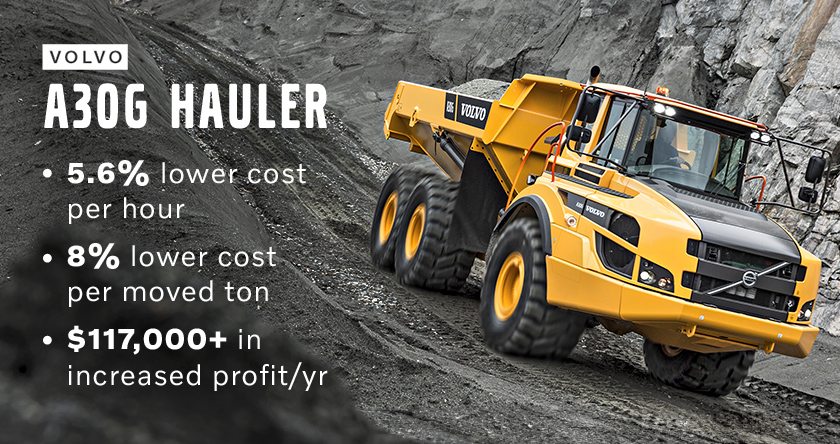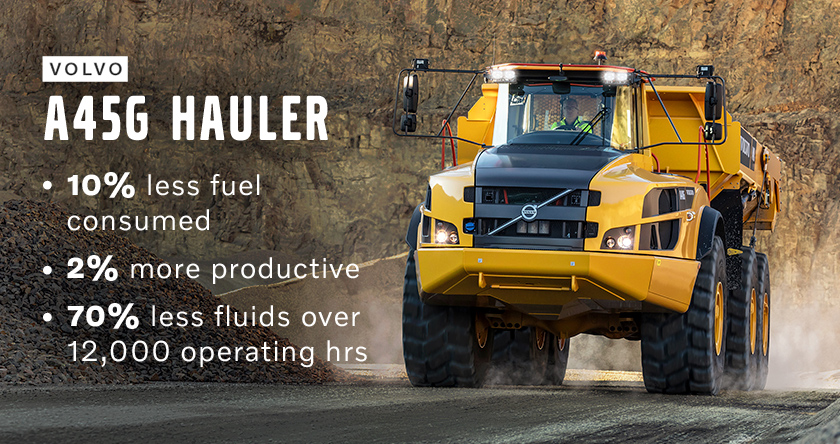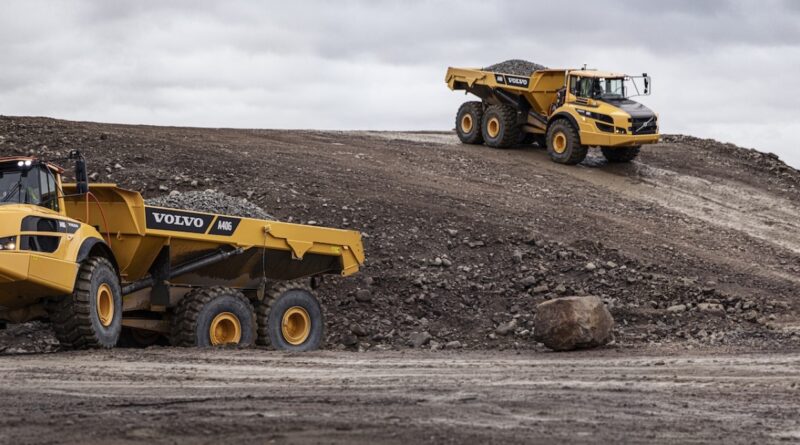Comparing Fuel Efficiency in Articulated Haul Trucks
You have more control than you may realize over the operating costs for your articulated haulers — and one of the easy line items to cut back on is fuel. Burning unnecessary fuel adds up over time, and the savings you get running more efficient machines may surprise you.
To demonstrate the savings you could experience, we put two Volvo articulated haulers up against comparable top competitor models — here’s what we found.
Test 1 Scenario: Volvo A30G Articulated Hauler vs. Top Competitor
We put our Volvo A30G haul truck up against a leading competitor to see how they compared on fuel efficiency. They ran 14 different medium- and heavy-duty cycles — five of those cycles were used for the results:
- Cycle 1: Loaded uphill (moderate 5-15% slopes)
- Cycle 2: Flat acceleration (short flat hauls)
- Cycle 3: Loaded downhill (moderate 5-15% slopes)
- Cycle 4: Long haul (longer cycle with varied conditions)
- Cycle 5: Elevated long haul (longer cycle with bigger elevation changes)
Both machines made the same cycles on the same day (minimizing the risk of weather interference), and both were loaded to gross machine weight, according to specs. A standard time was also set for loading and unloading ensuring it was equal for both machines. The tested competitive haul truck also had similar machine hours to the Volvo A30G that was used.
Measurements taken:
- Payload measured using a scale
- Cycle times and number of cycles
- Electronic fuel flow meters used
- GPS routes and cycle elevations
Calculated based on the measurements above:
- Productivity (t/h)
- Fuel consumption (gal/h, l/h)
- Fuel efficiency (t/gal, t/l)
Test 1 Results
- The A30G consumed 11% less fuel due to the competitive machine’s weight and non-matched drivetrain. And because the A30G consumes less fuel on average, it also consumes less AdBlue/DEF.
- During the idle consumption test, the A30G consumed over 50% less fuel at idle. It’s important to note that the idle-to-work ratio differs depending on application and site setup, but it’s not uncommon for articulated haulers to idle 30% of the total machine hours. High idling consumption affects the machine’s total fuel consumption.
- We were primarily testing fuel efficiency, but we also found that the Volvo A30G was 2% more productive thanks to its higher payload.

What do the numbers mean?
Even though the Volvo A30G has a higher retail price than the competitive model tested, it offers a 5.6% lower cost per hour and an 8% lower cost per moved ton. And with the competitive model requiring three times as much downtime for maintenance, the A30G also experiences more uptime week to week.
The Volvo A30G delivers 11% more profit per moved ton, which, according to this test, we’ve estimated to be just over $117,000 in increased profit per year. Like I said, the initial numbers may look small, but over time, it’s a significant savings.
Test 2 Scenario: Volvo A45G Articulated Hauler vs. Top Competitor
Our second test was set up in the same fashion as the first one above, ensuring both machines were measured on the same day, equally and fairly. For this test, however, we compared the Volvo A45G articulated hauler to a top competitor. Cycles tested included:
- Cycles 1 & 2: Long hauls, clockwise and counterclockwise (high speed, 1,733 yd / 1,630 m long, one way each)
- Cycles 3 & 4: Short hauls, uphill and downhill (394 yd / 360 m long, carrying material one way each)
- Cycles 5 & 6: Mixed hauls, clockwise and counterclockwise (623 yd / 570 m long, one way, varied terrain)
Test 2 Results
- The A45G consumed 10% less fuel throughout the test cycles.
- And while using the competitor’s ECO-mode does make it slightly more fuel efficient, it experiences 5% lower productivity, likely negating any meaningful savings. Even with the ECO-mode savings, the competitive hauler was still less efficient overall compared to Volvo.
In this side-by-side comparison, the Volvo A45G proved to be 2% more productive despite an equal payload.

What do the numbers mean?
In addition to burning less fuel, the Volvo A45G haul truck also moves more material per used gallon/liter of fuel. On top of that, the Volvo hauler requires less frequent oil change for axles, transmission and brake cooling and 70% less fluids over 12,000 operating hours, all of which affect the total cost of ownership of these machines.
The Bottom Line on Articulated Hauler Efficiency
If you’re in the market for a new articulated hauler, be sure to crunch the numbers to determine the haul truck’s total cost of ownership over simply comparing retail prices. With some OEMs, you may think you’re getting a better deal up front, but once you operate the trucks over months or years, the higher total cost of ownership will likely eat away at your profitability.
By factoring in initial purchase price plus operating costs like maintenance and fuel consumption to get the bigger picture, many customers find that opting for the more fuel-efficient haul truck is the smarter way to go. And with fuel prices fluctuating year to year, it’s one operating cost you have the power to better control.
Looking for more ADT data? Use our hauler-excavator pairing calculator to right size your Volvo haulers and excavators.
By Tyler Smith

